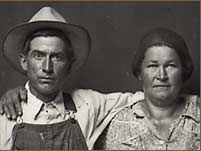I recently had a conversation with one of my fellow artists here at Ucross about studio portrait photography and this led to Mike Disfarmer. It reminded me of this post and the great comment left by one of his subjects’ ancestors, so I thought I’d repost it. And re: the last paragraph, I’m still grappling.
I was looking through Disfarmer, Heber Springs Portraits, 1939-1946, a gorgeous book of Mike Disfarmer’s photographs. The following paragraph from the essay by Julia Scully struck me.

What distinguishes this product of a seemingly ordinary Main Street portrait studio from that of others on every Main Street in the United States? In seeking an answer, we must consider the character of his subjects, the time in which they were recorded, and the photographer’s artistry.
This set me thinking: is there something that distinguishes A Life’s Work from other documentaries? The character of its subjects (unique) and the time in which they are recorded (now–there is no better time) are distinctive. But what about the filmmakers’ artistry?
Modesty prevents me from blowing my own horn, but I will say this: somehow I manage to inveigle cinematographers and editors of the highest artistic caliber to work on A Life’s Work. I like to think it’s the subject matter of the film that hits home–all artists want to create something that outlasts them. When the darkest clouds are hovering over the film, I think of my talented colleagues and their belief in the project and then more often than not those clouds disperse.
But about the Disfarmer photos! I feel like there’s something else going on between Mike Disfarmer and his portraits and me and A Life’s Work, but I can’t quite articulate it. Check out his photographs and if you can make a connection, let me know.

Jeff Barger
Interesting website. I was searching the Disfarmer photos online to see if my grandparents showed up anywhere. The photo you chose to put on your blog is of my father’s mother and father. Now I guess I’m going to have to see your documentary.
Cheers,
jb
David Licata
Jeff,
Wow, that is very cool! Thanks for sharing that!
And nah, you’re under no obligation to see A Life’s Work when it’s released. All I did was post a photo. I’d like to think, though, that you’d be curious about it.
Best,
David
Jeff Barger
I am curious about it. I shared it with my father as well. He’s excited to see it now. This same photo appears on the cover of the book he wrote about his mother, the woman in the photo. Here is a link to the book.
http://www.amazon.com/MAMIE-Ozark-Mountain-Girl-Courage/dp/1420888218/ref=sr_1_3?ie=UTF8&s=books&qid=1258384924&sr=8-3
Cheers.
David Licata
Great. The book looks fascinating. I’ll have to give it a read. Those Disfarmer photos conjure up an image of what Herber Springs was like, but it would be interesting to compare what is imagined with what was experienced.
I wish I could say Disfarmer had a place in my film, but alas, this is not so. But his photographs seemed to resonate with what I’m doing and that’s why I used the image of your grandparents. Why I chose that particular one of ALL the hundreds of images, I can’t say. Curious, isn’t it.
Best,
David
Eleni
A connection could be that you feel like you are seeing something of the subjects’ inner selves. They show some sort of emotion and you feel like you have some understanding of them. I think a Life’s Work gets inside its subjects, too, even though the questions they are asked aren’t necessarily personal.
David Licata
“I think A Life’s Work gets inside its subjects, too, even though the questions they are asked aren’t necessarily personal.”
Oh, that’s good! And how I hope it’s true. As always, thanks for comment, Eleni.